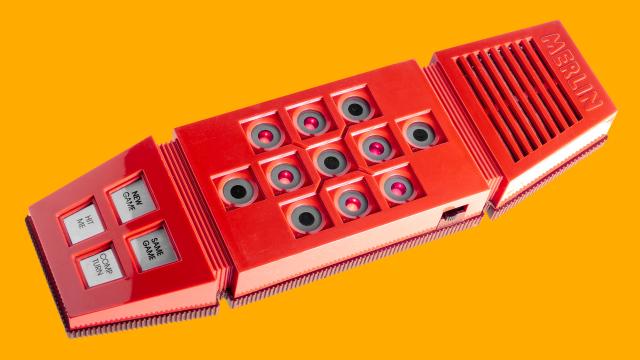Do you remember the first electronic game you ever played? Maybe it was Super Mario Bros. on the NES? Pitfall on the Atari 2600? Pac-Man at the arcade? For me it was Tic-Tac-Toe played on what looked like a cordless phone called Merlin The Electronic Wizard featuring a ‘screen’ made up of just 11 glowing dots.
I don’t remember exactly how old I was when my dad dug a box out of the closet adorned with images of a silver robotic hand embracing a curious red device — maybe five or six years old? — but it immediately captured my attention and distracted me from my Lego, Lincoln Logs, and die-cast cars. At that age, aside from a TV, hifi stereo, and the phone hanging in the kitchen, my exposure to electronics was almost non-existent, and the fact that my dad was not only showing me what this device could do, but letting me play with it all by myself, was kind of an epiphany. As far as I knew gadgets were for grown-ups and for mostly boring tasks, but this one was designed exclusively for fun.
Merlin The Electronic Wizard (or just Merlin, to get right to the point) was created in part by a man named Bob Doyle who, after getting his degree in astrophysics, went on to work for NASA where he helped develop software that allowed observatories on Earth to sync up with a telescope on Skylab, America’s first space station. From there, Doyle became an inventor and eventually formed a video game company with his brother-in-law called MicroCosmos. In the ‘70s, Parker Brothers was looking to get into electronic games and hired Doyle’s company to come up with a product that would feel more like a toy, and less like a device designed for engineers.
The collaboration gave birth to Merlin, which started life as a boring white box but soon evolved into a bright red handheld that, like a cordless phone, looked like it could be carried and enjoyed anywhere. Parker Brothers debuted Merlin at the New York Toy Fair in 1978 alongside Milton Bradley’s Simon which had more of a significant cultural impact than Merlin did, despite being technologically inferior. While Simon had just four light up buttons and a single memory game, Merlin featured 11 glowing buttons and six games, including Tic-Tac-Toe, Blackjack 13, Echo (the same game that Simon offered), and a basic music sequencer.
At that age I had already gotten bored of Tic-Tac-Toe and playing Blackjack really isn’t fun without the betting. So what drew me to Merlin was its music capabilities. Pressing each of the 11 buttons would produce a different tone, and the device let you record and play back a string of random button presses to create a song. The manual included step-by-step instructions on how to play several public domain tunes, but the real fun was creating my own musical masterpieces. In hindsight, I probably tested the limits of my parents’ patience with my sonic experiments because Merlin was released long before headphone jacks were a standard feature. As you can hear in the following video, Merlin’s crude sounds were not necessarily a treat for the ears.
Looking back, Merlin wasn’t much different than the other electronic handheld games released around the time, including a series of sports games from Mattel and Coleco. They all ran on 8-bit processors from companies like Intel and Texas Instruments and in lieu of even basic LCD screens used a grid of red LEDs which were the cheapest to manufacture at the time. What made Merlin still appealing to me years later was its design that allowed for multiple games to all run on the same device. Simon never appealed to me because it was a one-trick pony. If I got bored of music, I could always jump back to a quick game of Tic-Tac-Toe. As mobile distractions go, Merlin might be the closest thing to the smartphone’s great-great-great-grandparent.
Despite never being as popular as Simon (I don’t remember ever seeing a single Merlin toy commercial on TV as a kid, where as Simon seemed to be everywhere), Merlin The Electronic Wizard still went on to sell over 5.5 million units before being quietly discontinued sometime in the mid-’80s. It was groundbreaking when it was first released, but just a few years later Nintendo introduced its first Game & Watch handhelds with LCD displays featuring real graphics and animations. They, and the hundreds of LCD-based handhelds that were to follow from companies like Tiger Electronics, were much smaller and less power-hungry than Merlin was. Parker Brothers’ creation also faced stiff competition from the burgeoning home console market, and despite including multiple games, it didn’t come close to the number of games offered on consoles like the Atari 2600 and ColecoVision which used swappable game carts.
Like many of my childhood electronic toys, Merlin eventually died in storage, presumably at the hands of six AA batteries that corroded away over time. I wasn’t pleased to learn my parents had thrown it away, but I do appreciate them actually allowing me to enjoy and experiment with it when I was younger. I’m sure it was the catalyst for them bringing home a Commodore 64 a few years later, which was a fundamental part of my childhood and a big part of who I am today. But Merlin was definitely the first spark.
